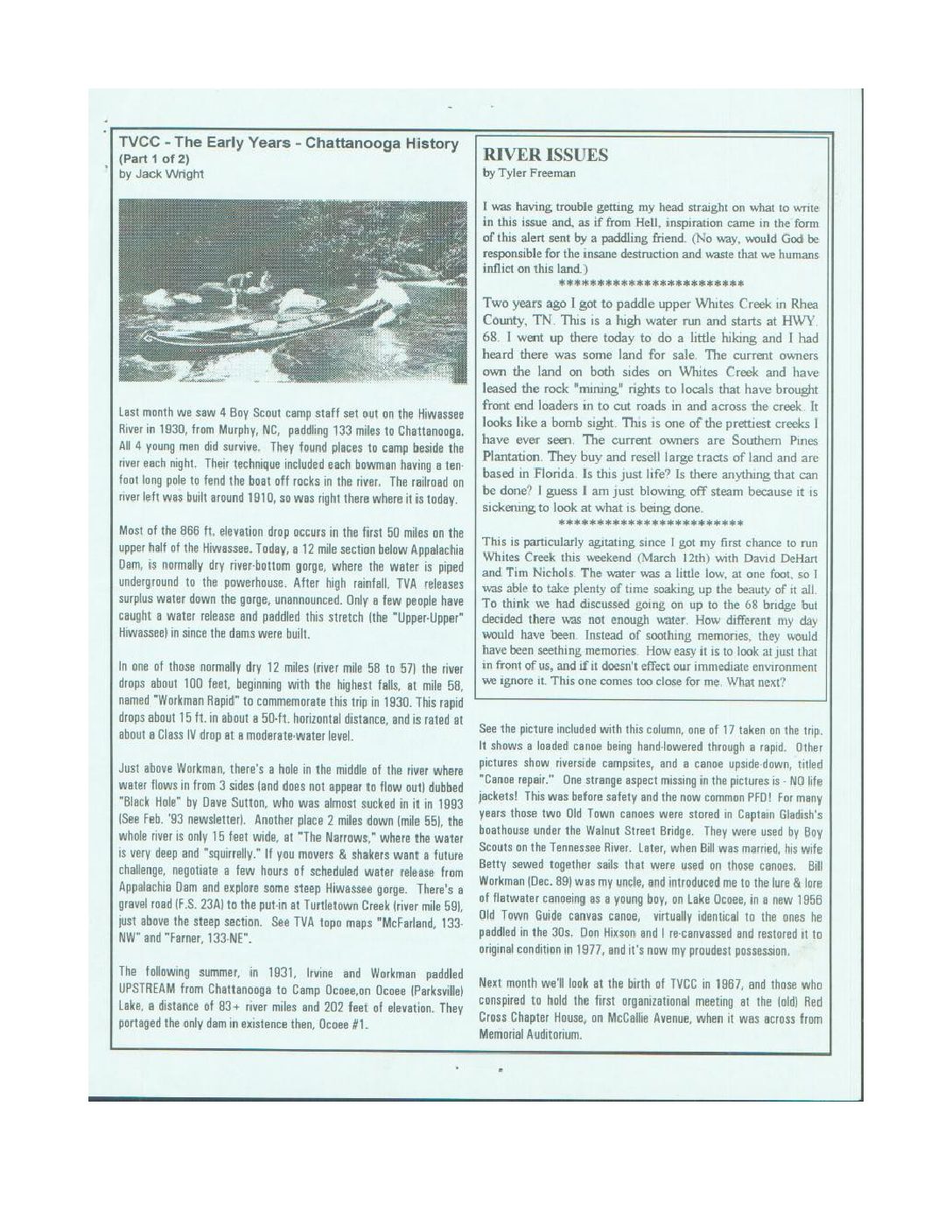The following article was reprinted from the original issue, TVCC April 2000 newsletter.
Provided by John Hubbard, TVCC Historian.
TVCC – The Early Years – History (Part 2 of 2)
by Jack Wright
Last month we saw 4 Boy Scout camp staff set out on the Hiwassee River in 1930, from Murphy, NC, padding 133 miles to Chattanooga. All 4 young men did survive. They found places to camp beside the river each night. Their technique included each bowman having a ten loot long pole to fend the boat off rocks in the river The railroad on river left was built around 1910, so was right there where it is today.
Most of the 866 ft elevation drop occurs in the first 50 miles of the upper half of the Hiwassee. Today, a 12 mile section section below Appalachia Dam is normally dry river-bottom gorge. where the water is piped underground to the powerhouse. After high rainfall. TVA releases surplus water down the gorge, unannounced. Only a few people have caught a water release and paddled this stretch (the “Upper Upper Hiwassee) since the dams were built.
In one of those normally dry 12 miles (river mile 58 to 57) the river drops about 100 feet, beginning with the highest falls, at mile 58, named “Workman Rapid” to commemorate this trip tn 1930. This rapid drops about 15 ft. in about a 50 ft. horizontal distance, and is rated at about a Class IV drop at a moderate water level.
Just above Workman, there’s a hole in the middle of the river where water flows in from 3 sides (and does not appear to flow out) dubbed “Black Hole” by Dave Sutton, who was almost sucked in it in 1993 (See Feb ’93 newsletter). Another place 2 miles down (mile 55), the whole river is only 15 feet wide, at “The Narrows” where the water is very deep and “squirrely” If you movers & shakers want a future challenge, negotiate a few hours of scheduled water release from Appalachia Dam and explore some steep Hiwassee gorge. There’s a gravel road (F.S. 23A) to the putin at Turtletown Greek (river mile 59) just above the steep section. See TVA topo maps “Mcfarland, 133-NW” and Farner, 133-NE”.
The following summer, in 1931, Irvine and Workman paddled UPSTREAM from Chattanooga to Camp Ocoee. on Ocoee Parksville lake a distance of 83+ river miles and 202 feet of elevation They portaged the only dam in existence then, Ocoee #1.
See the picture included with this column, one of 17 taken on the trip. It shows a loaded canoe being hand-lowered through a rapid. Other pictures show riverside campsites, and a canoe upside down, titled “Canoe repair.” One strange aspect missing tn the pictures is NO life jackets! Thus was before safety and the now common PFD! For many years these two Old Town canoes were stored in Captain Gladish’s boathouse under the Walnut Street Bridge. They were used by Boy Scouts on the Tennessee River. Later, when Bill was married, his wife Betty sewed together sails that were used on those canoes. Bill Workman (Dec. 89) was my uncle, and introduced me to the lure and lore of flatwater canoeing as a young boy, on Lake Ocoee, in a new 1966 Old Town Guide canvas canoe, virtually identical to the ones he paddled in the 30s. Don Hixson and I recanvassed and restored it to original condition in 1977, and it’s now my proudest possession.
Next month we’ll look at the birth of TVCC in 1967, and those who conspired to hold the first organizational meeting at the (old) Red Cross Chapter House, on McCallie Avenue, when it was across from Memorial Auditorium.

